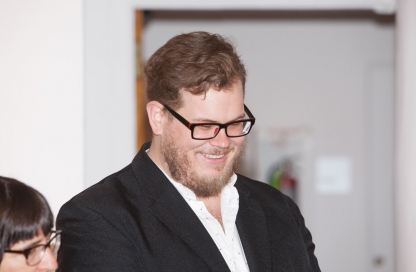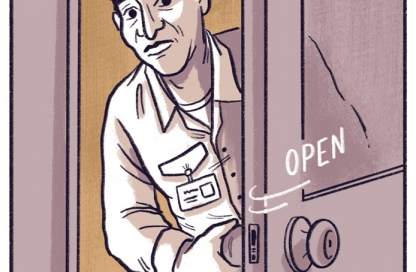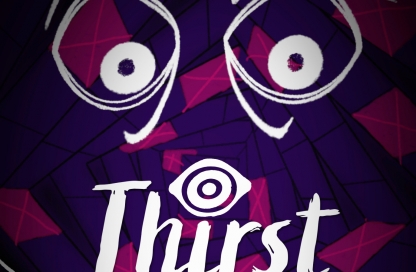Talking Comics with Tim | Duplicate’s Mark Sable
On Wednesday, Kickstart Comics (not to be confused with Kickstarter) will release Duplicate, the new graphic novel from writer Mark Sable and artist Andy MacDonald. The publisher describes the project as follows: “A seemingly ordinary family man sees his doppelganger and realizes he’s a clone. But not just any clone. A duplicate of the world’s deadliest secret agent. A decoy designed to spend time with The Agent’s family and otherwise provide cover while the spy is off saving the world.”
In addition to answering my questions about Duplicate, Sable was kind enough to share a slew of exclusive unlettered preview pages, which you will find at the end of the interview.
Tim O’Shea: Given that your publisher Kickstart is not one of the Big Two, I was pleasantly surprised to see they have priced your 88-page original graphic novel, Duplicate, at $8.99. Are you hoping the price point will give indie-comics fans more incentive to give the story a try?
Mark Sable: I hope most readers will check out the book for my story or Andy MacDonald’s art, but I’d be lying if I said I didn’t hope that the price point would be an extra reason to take a chance on the Duplicate. It’s Kickstart’s first foray into a full-size OGNs after doing digest-sized books like Rift Raiders (my previous OGN for them with Julian Totino Tedesco). I think in an economy like this, with 20 page single issues costing $3.99 or more each, having a complete story arc for $8.99 is our chance to compete with value as well as quality.
Duplicate is a mixture of science fiction and espionage; would you say it is somewhat in the vein of Nick Fury or Casanova?
Books like that, as well as the James Bond novels and films were some of my inspirations and the tone I was going for. I love darker, hard-edged spy stories like Queen and Country or Tinker Tailor Soldier Spy, and I’ve done that before with books like Unthinkable. But I want to Duplicate to have a sense of anything-can-happen fun. Doomsday scenarios, S.P.E.C.T.R.E.-like organizations, volcano headquarters … that’s the tradition Andy and I are operating in.
Folks who have enjoyed Graveyard of Empires know that you love to do research for your stories, what kind of research did you dive into for Duplicate?
With Graveyard, artist Paul Azaceta and I believed that if you had one fantastic element (zombies), everything else (the war in Afghanistan) had to be believable. In this case, aside from the robot duplicates, every other robot in the book is either real or on the drawing boards. Books like P.W. Singer’s Wired for War about the future of robotics and warfare, as well the Raymond Kurzweil documentary The Transcendent Man about the so-called “singularity” were helpful. I even considered creating and programming my own robot with LEGO Mindstorms, but really that would have just been an excuse to play with Legos.
When building your own universe/continuity in a story, half the fun is the background or mythology that proves as a foundation for the book. Can you tell me a little about that process?
I once heard a pre-prequel George Lucas describe how he’d want to put more in a single shot than the mind could process in one viewing to give the audience a sense that there was a detailed world that existed that they’d want to revisit, and I love any excuse to build one.
For Duplicate, the “good guy” spy organization is T.A.L.O.S., dedicated to ensuring the smooth flow of technological progress named for the world’s first automaton from Greek myth. They’re opposed by V.U.L.C.A.N., neo-Luddite anarchists who believe that technology only leads to deadlier ways for man to kill themselves, ironically named for the Roman god of metal works. Playing both ends against the one another is I.E.D., a criminal syndicate that believes the singularity – the hypothetical future emergence of greater-than-human super-intelligence through technological means – is a good thing, but something they want to control.
But while Andy and I have constructed a highly-detailed secret history of the world that dates back to Archimedes, all that is ultimately there to give our universe a lived-in feel while the focus is squarely on the present and our lead characters.
What prompted you to team with Andy MacDonald on this project?
The short answer is that quite simply, there is no one in comics who draws robots better than him. The slightly longer answer is that I’ve known Andy about as long as I’ve known anyone in the business. He drew NYC Mech, which was written and co-created by Ivan Brandon, who edited by first Image book, Grounded. I’ve waited the better part of a decade to work with him and I was thrilled when he said yes. I should also say that having Nick Filardi – who colored Andy on NYC Mech and Paul Azaceta on Grounded – really took Andy’s work to another level.
When potential consumers hear the basic premise for the book, they might want to dismiss this as Nick Fury homage. But I think the actual premise behind the hero (The Duplicate) makes it vastly different (and exploring the art of deception in a unique way). Is that what made you want to tell the story? Not every spy story considers the impact on the spy’s family, for example …
Duplicate is the story of Zekiel Dax, a family man and roboticist who survives a terrorist attack only to learn he himself is a robot. And not just any robot, but the robot duplicate for the world’s greatest super-spy. But whereas someplace like S.H.I.E.L.D. might use a Life Model Decoy to protect their agents in the field, our spy uses his Duplicate to be the perfect husband and father while he travels the world, gambles, womanizes and gets into whatever kind of trouble a secret agent with an unlimited expense account can.
Ultimately, the two are forced to work together, and that’s what the core of the story is to me. The Duplicate was created to protect the “real” Zekiel Dax’s family, and the best way to do that is make him overly cautious. Meanwhile, Dax the spy has lost his sense of responsibility. Duplicate is ultimately about the conflict of these two opposites trying to cooperate to put down what appears to be robot uprising – and hopefully change one another for the better.
So while we’re working in the tradition of Fury and Bond, unlike those franchise icons our heroes are free from the restrictions of having to exist for 50 years and can grow change. I hate saying my stories are “this meets that”, but I was pitching it to some artists at Los Angeles’ Drink and Draw last night and one of them said it’s like “True Lies meets Terminator.” I don’t think that’s a bad logline.
Unlike a creator at DC or Marvel, who has the benefit of a marketing team helping to get your name out, the responsibility of marketing your work falls on you. Do you find that to be more challenging or liberating (given that in marketing yourself you do not need to worry about marketing yourself AND the latest company giant crossover)?
It’s both challenging AND liberating. There’s part of me that wants to say that I didn’t get into writing for the attention, and I’m happiest when I’m concentrating on the writing or getting new pages from my artist. And I don’t consider myself to be the best marketing guy on the planet.
But one of the best things about comics as opposed to any other medium is the chance to interact with readers so directly. It helped draw me in as a fan and it’s what keeps me hear as a creator.
Creatively, the best part of doing creator-owned work is that when I’m lucky to have an editor (in this case, Kickstart’s Samantha Olsson), I have the luxury of knowing that any notes I get are going to be solely for the good of the book and not a need to protect a corporation’s trademark.
If I have to pay for that with less exposure or having to work a little harder at promotion I’ll take that option any time.
What else is in the creative pipeline for you in the near to long term?
I’m really looking forward to 2013. Aside from the trade for Graveyard of Empires (which will have a surprise from Paul Azaceta in it), I’ve got a few books I’m hoping will hit shelves. I’m co-writing/editing a book with The Last Starfighter creator Jonathan Betuel and artist Leandro Fernandez tentatively titled War Toys for Image Comics. It involves vigilantes using drones to police their city, so there’s some overlap in the research I did for Duplicate. I’ve also got another book for Kickstart called Blue Sky that deals with a post-apocalyptic world where the survivors are forced to live in airship cities above the clouds.
 Duplicate |
 Duplicate 56 |
 Duplicate 57 |
 Duplicate 58 |
 Duplicate 59 |
 Duplicate 60 |
 Duplicate 61 |
 Duplicate 62 |


